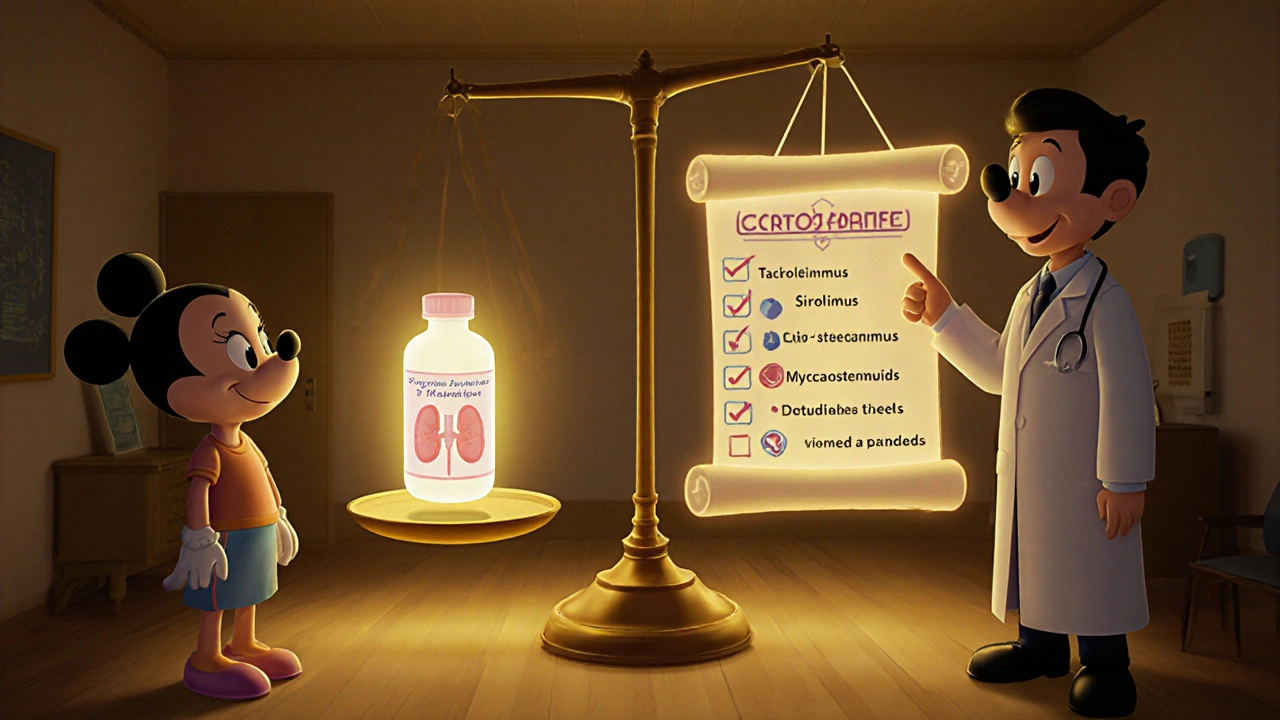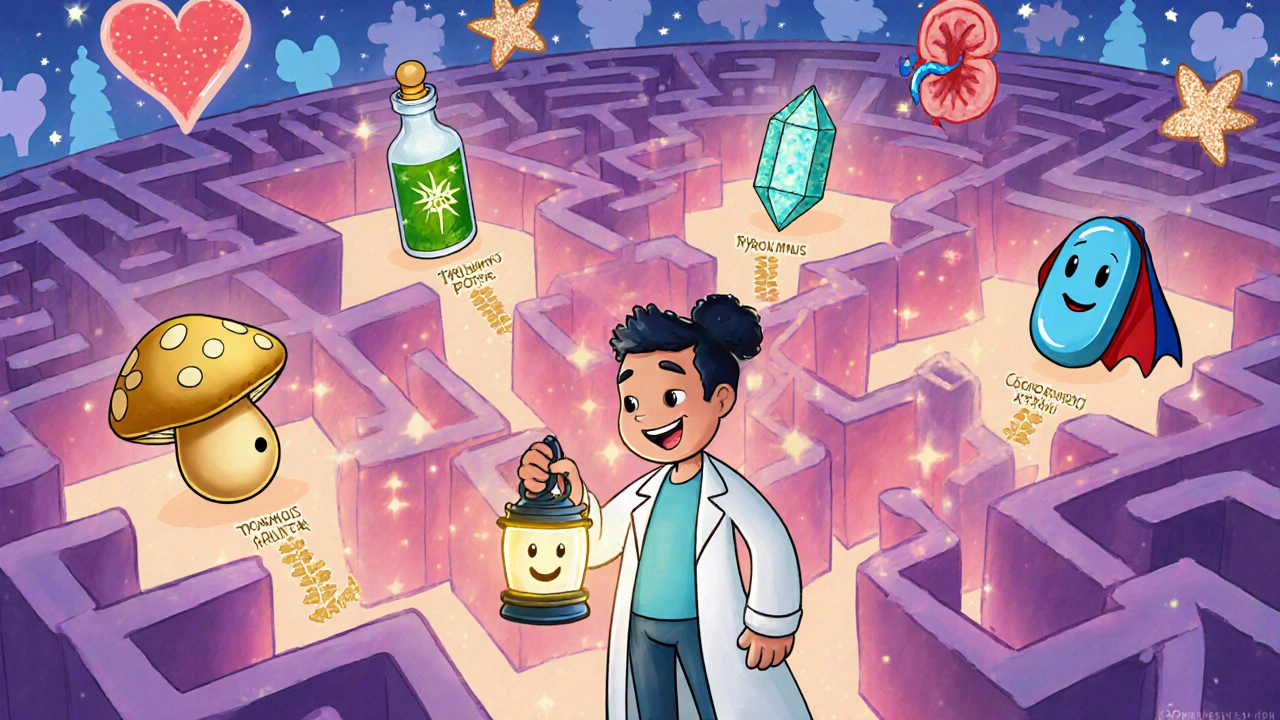Immunosuppressant Comparison Tool
This tool helps you compare immunosuppressants based on your priority criteria. Select the factors that matter most to your situation, then see which drug best meets your needs.
Choosing the right immunosuppressant can feel like navigating a maze of drug names, dosing schedules, and side‑effect profiles. Whether you’re a transplant recipient, a patient with an autoimmune disease, or a clinician drafting a treatment plan, you need a clear picture of how cyclosporine stacks up against its rivals. Below you’ll find a side‑by‑side look at the most common alternatives, practical guidance on when each shines, and a handy checklist to keep you from missing hidden pitfalls.
Key Takeaways
- Cyclosporine works by blocking calcineurin, but newer calcineurin inhibitors like tacrolimus often provide tighter blood‑level control.
- Sirolimus (rapamycin) targets a different pathway (mTOR) and is useful when kidney toxicity is a concern.
- Mycophenolate mofetil offers a non‑calcineurin option with a lower risk of hypertension and neuro‑toxicity.
- Corticosteroids remain inexpensive and fast‑acting but carry long‑term metabolic side effects.
- Choosing the right drug depends on the organ transplanted, renal function, comorbidities, and cost considerations.
What Is Cyclosporine?
Cyclosporine is a calcineurin inhibitor originally derived from the fungus Tolypocladium inflatum. It suppresses T‑cell activation by preventing the production of interleukin‑2, which is essential for the immune response that can reject a transplanted organ. First approved in 1983, cyclosporine quickly became the backbone of most solid‑organ transplant regimens.
Typical dosing ranges from 2mg/kg to 5mg/kg per day, split into two doses. Blood concentrations are monitored using a trough level (C0) target of 100‑400ng/mL, depending on the transplant type and time post‑operation. While effective, cyclosporine’s drawbacks include nephrotoxicity, hypertension, gum hyperplasia, and a high potential for drug‑drug interactions via the CYP3A4 pathway.
Leading Alternatives at a Glance
Below are the four most frequently used alternatives, each with its own mechanism, dosing quirks, and side‑effect spectrum.
Tacrolimus
Tacrolimus is a calcineurin inhibitor that, like cyclosporine, blocks interleukin‑2 synthesis but binds to a different intracellular protein (FKBP‑12). It’s marketed under the brand name Prograf, among others. Tacrolimus often achieves more stable blood levels and may reduce acute rejection rates, especially in kidney and liver transplants.
Typical oral dose: 0.1mg/kg per day in two divided doses. Target trough levels usually sit between 5‑15ng/mL, lower than cyclosporine’s range. Main side effects include nephrotoxicity (similar to cyclosporine), neuro‑toxicity (tremor, headache), and a higher incidence of diabetes mellitus.
Sirolimus (Rapamycin)
Sirolimus, also known as rapamycin, is an mTOR (mechanistic target of rapamycin) inhibitor. Instead of blocking calcineurin, it halts T‑cell proliferation downstream of interleukin‑2 signaling. Because it works on a different pathway, sirolimus can be paired with reduced doses of calcineurin inhibitors to lessen kidney toxicity.
Standard oral dose: 2mg daily after a loading phase, with target trough levels of 6‑15ng/mL. Notable adverse effects are hyperlipidemia, delayed wound healing, mouth ulcers, and a modest increase in infection risk.
Mycophenolate Mofetil (MMF)
Mycophenolate mofetil (MMF) inhibits inosine monophosphate dehydrogenase, an enzyme crucial for guanosine synthesis in lymphocytes. This non‑calcineurin mechanism makes MMF a valuable partner in regimens that aim to reduce nephrotoxic drug load.
Usual dosing: 1‑1.5g twice daily. Therapeutic drug monitoring is optional but can help fine‑tune exposure (target area under curve of 30‑60mg·h/L). Common side effects are gastrointestinal upset, leukopenia, and a higher risk of viral infections such as CMV.
Corticosteroids
Corticosteroids (e.g., prednisone, methylprednisolone) act broadly by dampening multiple inflammatory pathways, including cytokine production and immune cell trafficking. They are usually introduced at high doses during the immediate post‑transplant period and tapered over weeks to months.
Dosage varies widely; a typical starting regimen might be 20‑30mg of prednisone daily, reduced to a maintenance dose of 5‑10mg. While inexpensive and fast‑acting, long‑term use links to weight gain, osteoporosis, hyperglycemia, and heightened infection susceptibility.

How to Compare: Key Decision Criteria
When you line up cyclosporine against its contenders, focus on these six criteria. Each factor can tip the balance in a particular clinical scenario.
- Mechanism of Action - Determines synergy potential and side‑effect overlap.
- Pharmacokinetics - Absorption, half‑life, and need for therapeutic drug monitoring (TDM).
- Renal Impact - Degree of nephrotoxicity, crucial for kidney transplant patients.
- Metabolic Profile - Risk of diabetes, hyperlipidemia, hypertension.
- Infection Risk - Broad‑spectrum immunosuppression versus targeted inhibition.
- Cost & Accessibility - Generic availability, insurance coverage, and regional pricing.
Side‑by‑Side Comparison Table
| Drug | Mechanism | Typical Target Trough (ng/mL) | Renal Toxicity | Metabolic Side‑effects | Key Advantages | Typical Cost (USD/month) |
|---|---|---|---|---|---|---|
| Cyclosporine | Calcineurin inhibition (cyclophilin binding) | 100‑400 | High - dose‑dependent | Hypertension, hyperlipidemia, gum hyperplasia | Well‑studied, generic widely available | $20‑40 |
| Tacrolimus | Calcineurin inhibition (FKBP‑12 binding) | 5‑15 | Moderate - less than cyclosporine at equivalent immunosuppression | Diabetes, neuro‑toxicity, hypertension | More stable levels, lower acute rejection rates | $30‑60 |
| Sirolimus | mTOR inhibition | 6‑15 | Low - often used to spare kidneys | Hyperlipidemia, delayed wound healing | Can be combined with low‑dose calcineurin inhibitors | $45‑80 |
| Mycophenolate mofetil | Inosine monophosphate dehydrogenase inhibition | 30‑60mg·h/L (AUC) - optional TDM | Low - non‑nephrotoxic | GI upset, leukopenia, viral infections | Useful in steroid‑sparing regimens | $25‑50 |
| Corticosteroids | Broad anti‑inflammatory, multiple pathway inhibition | - (dose‑based) | Low renal toxicity | Weight gain, osteoporosis, hyperglycemia | Rapid onset, inexpensive | $5‑15 |
When to Choose Cyclosporine Over Alternatives
Despite its side‑effect profile, cyclosporine still earns a seat at the table in specific situations:
- Heart transplant patients - Historical data show comparable survival when cyclosporine is combined with azathioprine and steroids.
- Resource‑limited settings - Generic cyclosporine is often the cheapest calcineurin inhibitor, making it the default choice in many public‑health systems.
- Patients with a strong intolerance to tacrolimus - Some individuals develop severe tremors or new‑onset diabetes on tacrolimus, prompting a switch back to cyclosporine.
- When therapeutic drug monitoring (TDM) infrastructure is limited - Although cyclosporine requires TDM, its target range is broader, allowing less precise labs to still provide safe dosing.

When an Alternative Is the Better Fit
In many modern transplant protocols, one of the alternatives outweighs cyclosporine’s benefits:
- Kidney transplant recipients with borderline renal function - Tacrolimus or a low‑dose tacrolimus+sirolimus combo reduces cumulative nephrotoxicity.
- Patients at high risk for metabolic syndrome - Switching from cyclosporine to mycophenolate and low‑dose steroids can curb hypertension and hyperlipidemia.
- Those needing rapid wound healing - Sirolimus can delay surgical site healing; therefore, cyclosporine (or tacrolimus) is preferred in the immediate post‑op period.
- Long‑term maintenance with steroid minimization - Mycophenolate paired with low‑dose tacrolimus offers a steroid‑sparing strategy with good graft survival.
Practical Tips & Common Pitfalls
Regardless of the drug you settle on, these practical pointers can help you avoid costly mistakes.
- Always schedule regular trough level checks. Missing a single measurement can allow toxic peaks, especially with cyclosporine’s narrow therapeutic window.
- Watch for drug‑drug interactions. Both cyclosporine and tacrolimus are metabolized by CYP3A4; grapefruit juice, certain antibiotics, and antifungals can dramatically raise levels.
- Adjust doses for renal impairment. Even low‑dose tacrolimus accumulates in patients with eGFR<30mL/min/1.73m².
- Consider genetic testing. CYP3A5 *1/*1 expressors tend to need higher tacrolimus doses, whereas *3/*3 carriers may stay within target levels on lower doses.
- Educate patients on symptom monitoring. Early signs of nephrotoxicity (rising creatinine), neuro‑toxicity (tremor, confusion), or metabolic shifts (new‑onset diabetes) should trigger prompt lab work.
Frequently Asked Questions
Is cyclosporine still used in kidney transplants?
Yes, but many centers now prefer tacrolimus because it offers comparable graft survival with less nephrotoxicity. Cyclosporine may still be chosen when cost constraints or specific drug intolerance factors come into play.
Can I switch from cyclosporine to mycophenolate without losing protection?
A direct switch is possible, but it should be done gradually and under close monitoring. Most protocols add mycophenolate first, then taper cyclosporine over 2‑4 weeks while checking trough levels and renal function.
Why does tacrolimus cause diabetes more often than cyclosporine?
Tacrolimus impairs pancreatic beta‑cell function and increases insulin resistance, especially at higher trough levels. This effect is less pronounced with cyclosporine, making tacrolimus a risk factor for new‑onset diabetes after transplantation (NODAT).
Is sirolimus safe for patients with high cholesterol?
Sirolimus can raise LDL and triglyceride levels, so it’s generally avoided in patients with uncontrolled hyperlipidemia unless lipid‑lowering therapy is concurrently prescribed.
How do I know which drug is cheapest for my insurance?
Check your pharmacy benefits manager’s formulary or call the insurer’s drug‑coverage line. In many regions, generic cyclosporine and mycophenolate are the most affordable, while branded tacrolimus and sirolimus can be significantly pricier.
By lining up the mechanism, side‑effect profile, monitoring needs, and cost, you can pick the immunosuppressant that best matches the patient’s condition, lifestyle, and financial situation. Whether you stay with cyclosporine or move to a newer agent, the goal remains the same: keep the graft thriving while minimizing harm.

Cyclosporine has been a cornerstone of transplant medicine since the early eighties 😊 It works by binding cyclophilin and halting calcineurin activity which stops IL‑2 production This mechanism makes it effective across many organ types The drug’s dosing is weight based and often split into two doses each day Monitoring trough levels is essential because the therapeutic window is narrow You’ll find target levels vary from 100 to 400 ng/mL depending on the transplant type and time post‑op The downside is the well‑known nephrotoxicity which can accelerate kidney decline especially in patients with borderline function Hypertension and gum overgrowth are also common side effects The drug interacts heavily with CYP3A4 so grapefruit juice or certain antibiotics can cause dangerous spikes The cost is relatively low which makes it attractive in resource‑limited settings The generic versions are widely available and insurance often covers them The long‑term data show good graft survival when combined with steroids and azathioprine However newer calcineurin inhibitors like tacrolimus often give tighter level control and lower acute rejection rates The choice between cyclosporine and tacrolimus can hinge on patient tolerance to tremor or new‑onset diabetes The metabolic profile of cyclosporine includes hyperlipidemia which may need statin therapy The practical tip is to schedule regular labs and adjust doses promptly The drug also requires patient education about adherence because missed doses can lead to rejection Finally remember that while cyclosporine remains a viable option its side‑effect burden pushes many clinicians toward alternatives in modern protocols 😊
Great summary! 🎉 The checklist you added really helps keep everything straight.
I appreciate how the article breaks down each drug’s pros and cons in a clear table. For patients who are new to immunosuppression, seeing the renal toxicity column side by side makes the decision less intimidating. It’s also useful to note that cost can be a deciding factor in many health systems. Keeping an eye on drug‑drug interactions, especially with CYP 3A4 substrates, is a practical tip that many overlook. Overall, this guide feels like a solid starting point for both clinicians and patients alike.
Indeed, understanding the underlying mechanisms can illuminate why certain side‑effects emerge, turning a complex regimen into a more approachable narrative.
One thing to add is that cyclosporine can cause a weird taste sensation for some folks – kinda metallic. Also, make sure patients know that rapid dose changes without lab confirmation can cause rejection or toxicity. If you’re switching from tacrolimus, taper slowly and monitor kidney function closely. It’s easy to miss the subtle rise in blood pressure, so home BP checks are a good habit. Lastly, generic formulations are bioequivalent, but occasional patients report different side‑effect profiles, so keep an eye out.
Wow, thanks for the "expert" tips, really groundbreaking stuff like “watch your blood pressure”. As if we didn’t already know that from the label. 🙄
!!!Seriously???!!! You’re just restating the label!!! What about the impact on lipid profiles!!!!!!
Choosing the right drug isn’t a lottery it’s a strategic decision based on patient specifics.
Sure, because blanket statements always work.
Got to love the way immunosuppressants each have their own personality 😅.
In the theater of transplantation, each medication steps onto the stage with a destiny intertwined with the patient’s hope, the surgeon’s skill, and the relentless march of time.
The pharmacokinetic variability of calcineurin inhibitors, particularly cyclosporine, presents a formidable challenge in clinical practice; the drug’s absorption is highly dependent on food intake, gastrointestinal motility, and concurrent medications, which can lead to unpredictable trough levels despite diligent dosing regimens. Moreover, the narrow therapeutic index necessitates frequent monitoring, and even slight deviations from target concentrations can precipitate either subtherapeutic immunosuppression, risking graft rejection, or supratherapeutic exposure, increasing the likelihood of nephrotoxicity and hypertension. It is therefore incumbent upon clinicians to employ a comprehensive approach that includes patient education, adherence counseling, and the use of validated analytical methods for level assessment. Incorporating pharmacogenomic data where available may further refine dosing strategies, especially in populations with known CYP3A5 polymorphisms. Ultimately, an individualized regimen that balances efficacy with safety remains the gold standard for optimizing transplant outcomes.